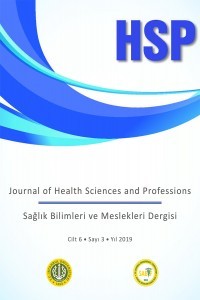Sigara İçen Sağlıklı Erkeklerde Egzersiz Sonrası Kan Laktat Düzeyindeki Değişim İle İlişkili Faktörlerin İncelenmesi
sigara içme, laktik asid, yorgunluk, kuvvet
Investigatıon of the Factors Related to Change in Blood Lactate Level After Exercse in Healthy Male Cigarette Smokers: A Pilot Study
smoking, lactic acid, fatigue, strength,
___
- 1. McGinnis JM, Foege WH. Actual causes of death in the United States. JAMA. 1993;270(18):2207-12.
- 2. World Health Organization. Report on the Global Tobacco Epidemic. Country Profile: Turkey 2017 http://www.who.int/tobacco/surveillance/policy/country_profile/tur.pdf?ua=1.
- 3. Kaczynski AT, Manske SR, Mannell RC, Grewal K. Smoking and physical activity: a systematic review. Am J Health Behav. 2008;32(1):93-110.
- 4. Conway TL, Cronan TA. Smoking, exercise, and physical fitness. Prev Med. 1992;21(6):723-34.
- 5. Durutürk N, Acar M. Üniversite Öğrencilerinde Sigara Tüketiminin Egzersiz Kapasitesi ve Sağlıkla İlgili Fiziksel Uygunluk Düzeyi Üzerine Etkisi [The Effects of Cigarette Consumption on Exercise Capacity and Health-Related Physical Fitness Level on University Students]. BÜSBİD. 2016;1(2):34-45.
- 6. Metin G, Yücel R, Altan M, Öztürk L, Tutluoğlu B. Sigarayı bırakmanın fiziksel egzersiz kapasitesi üzerine etkileri [Effects of Smoking Cessation on Physical Exercise Capacity]. Toraks Derg [Turk Thorac J]. 2005;6(3):221-7.
- 7. Uysal MA, Kadakal F, Karşidağ C, Bayram NG, Uysal O, Yilmaz V. Fagerstrom test for nicotine dependence: reliability in a Turkish sample and factor analysis. Tuberk Toraks. 2004;52(2):115-21.
- 8. Öztürk M. (2005) Üniversitede Eğitim-Öğretim Gören Öğrencilerde Uluslararası Fiziksel Aktivite Anketinin Geçerliliği Ve Güvenirliği Ve Fiziksel Aktivite Düzeylerinin Belirlenmesi. Yüksek Lisans Tezi. Hacettepe Üniversitesi Sağlık Bilimleri Enstitüsü.
- 9. Craig CL, Marshall AL, Sjöström M, Bauman AE, Booth ML, Ainsworth BE et al. International Physical Activity Questionnaire: 12-Country Reliability and Validity. Med Sci Sports Exerc. 2003;35(8):1381–95.
- 10. Mentiplay BF, Perraton LG, Bower KJ, Adair B, Pua YH, Williams GP et al. Assessment of Lower Limb Muscle Strength and Power Using Hand-Held and Fixed Dynamometry: A Reliability and Validity Study. PLoS One. 2015;10(10):e0140822. doi:10.1371/journal.pone.0140822.
- 11. Milanović Z, Sporiš G, Weston M. Effectiveness of High Intensity Interval Training (HIT) and Continuous Endurance Training for VO2max Improvements: A Systematic Review and Meta-Analysis of Controlled Trials. Sports Med. 2015;45(10):1469-81.
- 12. Huie MJ, Casazza GA, Horning MA, Brooks GA. Smoking increases conversion of lactate to glucose during submaximal exercise. J Appl Physiol. 1996;80(5):1554-9.
- 13. Huie MJ. The effects of smoking on exercise performance. Sports Med. 1996;22(6):355-9.
- 14. Mündel T, Jones DA. Effect of transdermal nicotine administration on exercise endurance in men. Exp Physiol. 2006;91(4):705-13.
- 15. Goodwin ML, Harris JE, Hernández A, Gladden LB. Blood lactate measurements and analysis during exercise: a guide for clinicians. J Diabetes Sci Technol. 2007;1(4):558-69.
- 16. Lee CL, Chang WD. The effects of cigarette smoking on aerobic and anaerobic capacity and heart rate variability among female university students. Int J Womens Health. 2013;5:667-79.
- 17. Baumgartner RN, Koehler KM, Gallagher D, Romero L, Heymsfield SB, Ross RR et al. Epidemiology of sarcopenia among the elderly in New Mexico. Am J Epidemiol. 1998;147(8):755-63.
- 18. Szulc P, Duboeuf F, Marchand F, Delmas PD. Hormonal and lifestyle determinants of appendicular skeletal muscle mass in men: the MINOS study. Am J Clin Nutr. 2004;80(2):496-503.
- 19. Kok MO, Hoekstra T, Twisk JW. The longitudinal relation between smoking and muscle strength in healthy adults. Eur Addict Res. 2012;18(2):70-5.
- 20. Morse CI, Wüst RC, Jones DA, de Haan A, Degens H. Muscle fatigue resistance during stimulated contractions is reduced in young male smokers. Acta Physiol (Oxf). 2007;191(2):123-9.
- ISSN: 2148-7588
- Başlangıç: 2014
- Yayıncı: İstanbul Üniversitesi-Cerrahpaşa
Sağlık Bilimleri ve Meslekleri Dergisi Cilt 6 Sayı 1 Yıl 2019
Sağlık Bilimleri Ve Meslekleri Dergisi HSP
Ameliyathanelerde Cerrahi Dumanın Etkileri ve Korunmaya Yönelik Alınan Önlemler
Esra USTA, Dilek AYGİN, Havva BOZDEMİR, Nursen UÇAR
Sülforafan, Potansiyel Etki Mekanizması ve Hastalıklarla İlişkisi
Hemşire-Hemşire İşbirliği Ölçeği’nin Geçerlik ve Güvenirliği
Elif TEMUÇİN, İlknur Dolu, Maral KARGIN
Barsak Mikrobiyotası ve Dayanıklılık Egzersizleri
Sezaryen Doğum Kararına Ebe Farkındalığı İle Etik Yaklaşım
Gülhumar NURİ TURAL, Aslı SİS ÇELİK
Ebelik Öğrencilerinin Empatik Eğilim ve Empatik Beceri Düzeyleri
